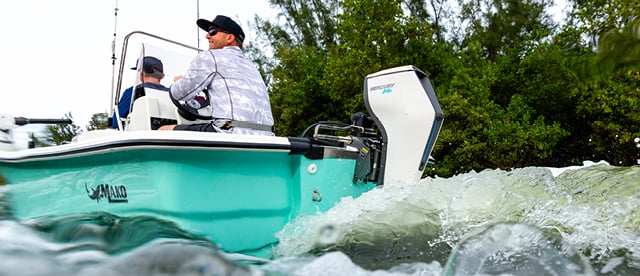Regardless of the species you like to fish for, spooling a spinning reel is a task you’ll need to tackle from time to time. There are several ways to spool a spinning reel, and while filling the reel with line isn’t a difficult process, there are some common and frustrating issues that can occur if not done properly. To avoid these headaches, we’ve provided some simple spinning reel-spooling tips. Follow this advice to make sure you spend more time fighting fish and less time fighting your spinning reel and line on the water.
1. Beware of line memory – Monofilament and fluorocarbon lines have “memory.” When they’re wrapped on the spool at the factory, memory causes them to take on a natural curve or curl. Because of this, they need to be spooled onto the reel in a certain way to match this curve. If you go against the memory, the line won’t lie or flow out smoothly, and you’ll spend most of your time fighting it.
2. Lay small filler spools flat – Most common filler, or “pony size,” spools hold approximately 330 yards of line or less and are compact. When using one of these to fill your reel, the easiest method is to lay the spool on the ground in front of you. Start with the spool’s label facing up and turn the reel handle five or six times, keeping slight tension by running the line through two fingers just in front of the reel. Then stop, drop some slack in the line and see if it has large, loose natural curls or if it forms twists. If you have loose curls, continue spooling as you were. If you have a section of twisted line, flip the spool over on the ground so the label is down and try it again. This time, the line will come off the spool the opposite way, and you should get no twist in the line.
3. Fill from the bottom of big spools – If you have a large bulk or service spool, it’s easiest to use some type of line-spooling station or other device to hold the spool while you fill the reel. This can range from fancy store-bought systems all the way to simple homemade versions, but they all usually have a metal rod that passes through the center of the spool and holds the spool horizontally. High-end models apply a bit of pressure to keep the spool from spinning too fast as line comes off. When using a spooling station to fill a spinning reel, make sure the line is coming off the spool from the bottom side to avoid twisting. It’s important to note that, if you were to spool a baitcasting reel this way, you’d want to flip the spool, so the line is coming off from the top. If you don’t have a line-spooling station, you can have a friend hold a pencil or screwdriver through the middle of the spool.
4. Keep tension on the line – Whichever of these methods you use, use your fingers to keep just enough tension on the line so it can be guided off the spool and onto the reel without causing any disruption. It’s easiest to lightly hold the line directly in front of the spool. This helps the line to go on tight and even and lie flat on the reel’s spool.
5. Use backing with braid – Braid lines, or “super lines,” generally have little to no memory and can be spooled onto the reel without much thought after a few simple steps. Braids have very little stretch and can be very slick, so much so that they don’t grip the reel’s spool. When pressure is applied, the line can actually slip, preventing the reel’s drag from working or even keeping you from taking in line. To avoid slip, first spool on enough monofilament line to cover the reel’s spool, then connect the braid. This layer of mono is called backing. It grips the reel enough to prevent slippage. Depending on the spool size and the fish you are targeting, it’s not a bad idea to add a little more monofilament to partially fill the reel and save some braided line. Mono is generally less expensive, so you’ll save money this way, and as long as you don’t put on too much backing, the mono will never actually come off the reel on a cast or while fighting a fish. Many different types of knots can be used to make this splicing connection, but an easy and effective one is the double uni knot.
6. Slow down – Especially when filling large spinning reels, it is very tempting to use a high-speed electric spooler (many tackle shops offer this service), but old-fashioned hand power is often the way to go. High-rpm machines put line on at a fast rate, but they can actually create enough friction to damage the outer coating of the line. When done this way, you can even see the residue from the damaged outer coating on your hands, on the machine’s line guide or below the machine. This damage can cause the line to become chalky, which makes the line opaque and more visible in the water. Even worse, it can weaken the line. When using a machine, it’s also very easy to spool the line on too tight, compacting it on the spool, which could cause issues while casting. Stick to spooling reels by hand to avoid these issues.
7. Don’t overfill – Overfilling a reel is one of the easiest ways to cause issues during a cast. Fill the reel spool until the line is approximately 1/8 inch from the lip. This makes casting easier because, as the line becomes less tight on the reel spool, you still have plenty of room for the layers to expand out without slipping off the spool and possibly underneath to the rotor.
Spool Right, Spool Often
Spooling a spinning reel the right way is important for angling success, and these tips can help. Once you master this process, you’ll feel more comfortable replacing the line regularly. There are a variety of reasons that line needs to be replaced. Like most things, the more you use it, the sooner it will need to be replaced. If abrasion weakens the line or the spool’s capacity becomes too low from retying or breaking off, it likely needs to be changed. Also, UV rays can weaken fishing line even when it’s not being used. In most cases, monofilament and fluorocarbon line need to be changed more frequently than braid due to memory and because they break down faster than braid. Just like flossing your teeth, you need to do it more than once a year.




